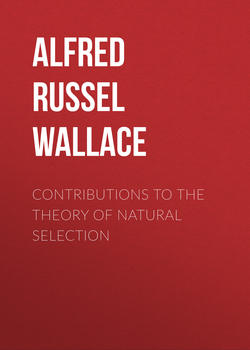Читать книгу Contributions to the Theory of Natural Selection - Alfred Russel Wallace, Alfred Russel Wallace - Страница 10
I.
ON THE LAW WHICH HAS REGULATED THE INTRODUCTION OF NEW SPECIES. 1
Rudimentary Organs
ОглавлениеAnother important series of facts, quite in accordance with, and even necessary deductions from, the law now developed, are those of rudimentary organs. That these really do exist, and in most cases have no special function in the animal oeconomy, is admitted by the first authorities in comparative anatomy. The minute limbs hidden beneath the skin in many of the snake-like lizards, the anal hooks of the boa constrictor, the complete series of jointed finger-bones in the paddle of the Manatus and whale, are a few of the most familiar instances. In botany a similar class of facts has been long recognised. Abortive stamens, rudimentary floral envelopes and undeveloped carpels, are of the most frequent occurrence. To every thoughtful naturalist the question must arise, What are these for? What have they to do with the great laws of creation? Do they not teach us something of the system of Nature? If each species has been created independently, and without any necessary relations with pre-existing species, what do these rudiments, these apparent imperfections mean? There must be a cause for them; they must be the necessary results of some great natural law. Now, if, as it has been endeavoured to be shown, the great law which has regulated the peopling of the earth with animal and vegetable life is, that every change shall be gradual; that no new creature shall be formed widely differing from anything before existing; that in this, as in everything else in Nature, there shall be gradation and harmony,—then these rudimentary organs are necessary, and are an essential part of the system of Nature. Ere the higher Vertebrata were formed, for instance, many steps were required, and many organs had to undergo modifications from the rudimental condition in which only they had as yet existed. We still see remaining an antitypal sketch of a wing adapted for flight in the scaly flapper of the penguin, and limbs first concealed beneath the skin, and then weakly protruding from it, were the necessary gradations before others should be formed fully adapted for locomotion.3 Many more of these modifications should we behold, and more complete series of them, had we a view of all the forms which have ceased to live. The great gaps that exist between fishes, reptiles, birds, and mammals would then, no doubt, be softened down by intermediate groups, and the whole organic world would be seen to be an unbroken and harmonious system.
3
The theory of Natural Selection has now taught us that these are not the steps by which limbs have been formed; and that most rudimentary organs have been produced by abortion, owing to disuse, as explained by Mr. Darwin.
